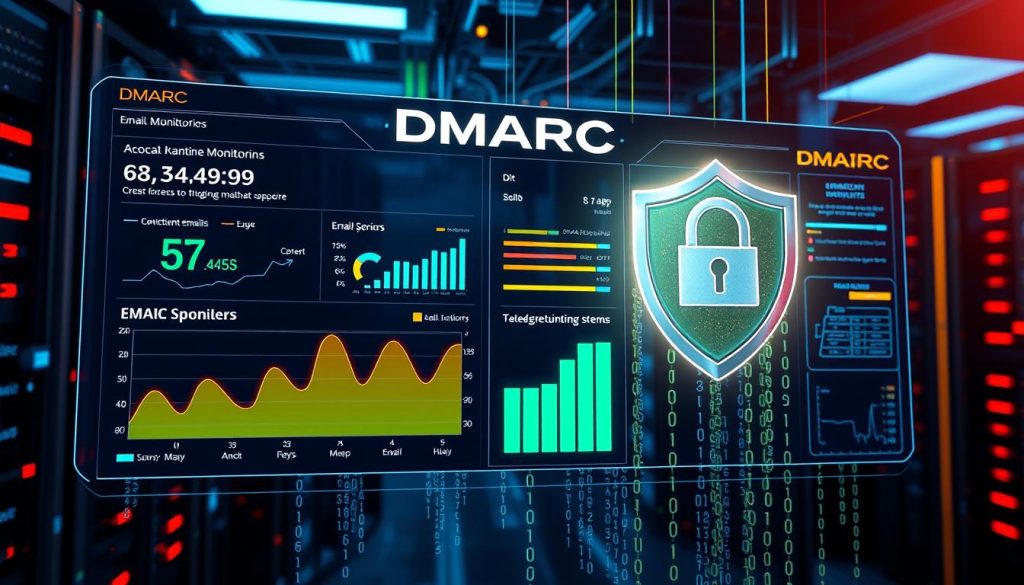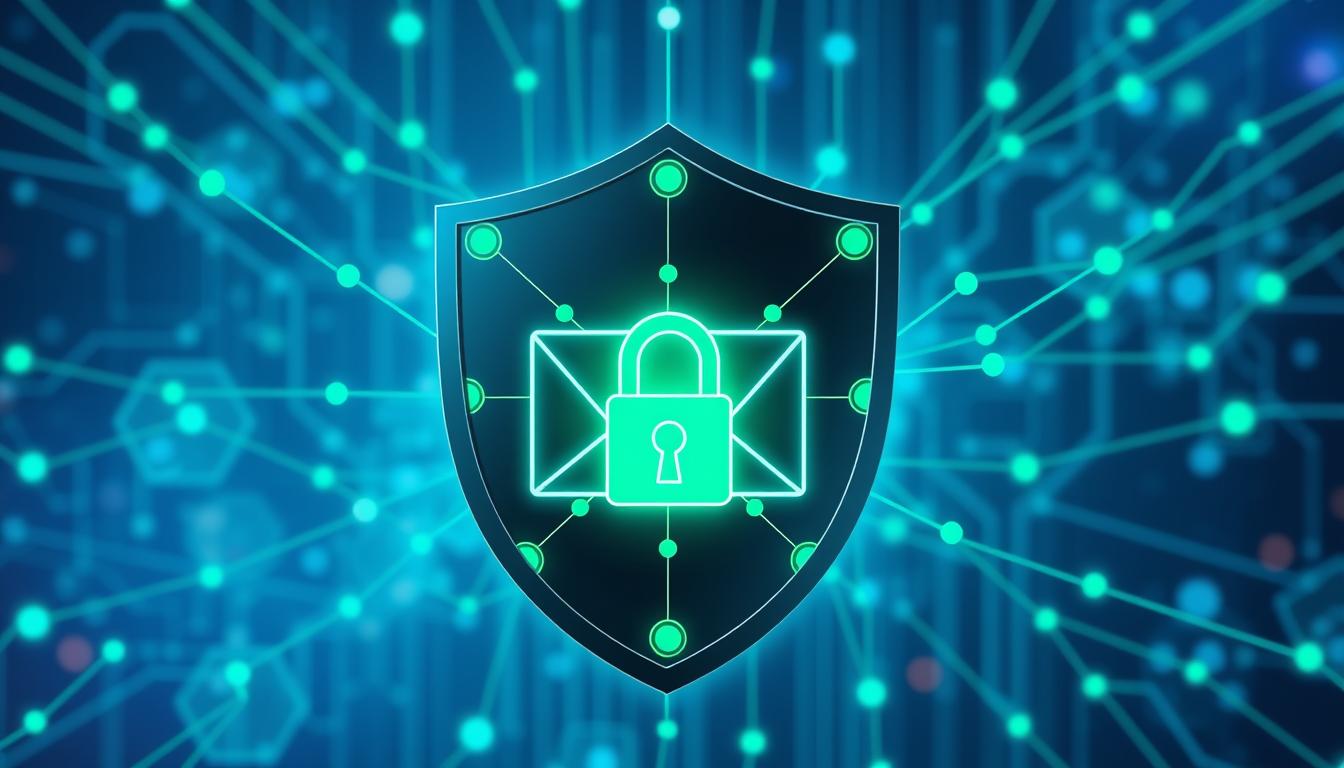Email is still a key tool in digital marketing for reaching out to customers and growing businesses. But, with more advanced email systems, strong authentication is now a must. DMARC, or Domain-based Message Authentication, Reporting, and Conformance, is a big help for cold email campaigns.
This guide will cover the key email authentication methods: DMARC, DKIM, and SPF. You’ll learn how they boost your cold email’s success and security. Discover how to use these tools to keep your domain safe, increase email success, and follow industry rules.
Key Takeaways
- DMARC is a critical email authentication protocol that helps prevent email spoofing and improve email deliverability.
- Understanding the interplay between DMARC, DKIM, and SPF is essential for ensuring the security and success of your cold email campaigns.
- Implementing DMARC can effectively protect your domain’s reputation and build trust with your recipients.
- Monitoring and analyzing DMARC reports can provide valuable insights to optimize your email marketing strategy.
- Adhering to best practices and troubleshooting common DMARC-related challenges can help you overcome roadblocks in your cold email outreach.
What is DMARC?
DMARC stands for Domain-based Message Authentication, Reporting, and Conformance. It’s a key email security standard. It helps domain owners check if emails are really from their domain. This reduces the chance of spoofing and phishing attacks.
Understanding Domain-based Message Authentication, Reporting, and Conformance
DMARC is a team effort between email senders and receivers to fight email fraud. It uses DKIM and SPF to ensure emails are genuine. This makes email communication safer.
With DMARC, domain owners can tell email receivers what to do with unverified emails. They can choose to reject or quarantine them. This protects their brand and customers from scams.
- DMARC checks if emails match the domain’s DKIM and SPF settings.
- It lets domain owners decide how to handle unverified emails.
- DMARC offers detailed reports on email traffic, helping domain owners understand their email activity.
Knowing about DMARC is key for businesses that use email a lot. Especially those doing cold email campaigns. By using DMARC, they can make their emails safer and more reliable. This helps protect their brand and builds trust with their audience.
“DMARC is a critical email authentication protocol that helps domain owners take control of their email ecosystem and mitigate the risks of email spoofing and phishing.”
The Importance of DMARC in Cold Email Campaigns
In cold email marketing, keeping a good email reputation is key. DMARC (Domain-based Message Authentication, Reporting, and Conformance) is vital for your campaign’s success. It helps protect your domain from misuse and keeps your brand’s image intact.
Email deliverability is essential for cold email success. When your emails reach the inbox, you’re more likely to get leads and convert prospects. Without DMARC, spammers and phishers target your domain, harming your reputation and deliverability.
DMARC works with DKIM and SPF to check if your emails are real. This setup creates a strong email security system. It stops unauthorized senders from using your domain, keeping your cold email campaigns safe.
“Implementing DMARC is a crucial step in safeguarding your domain and ensuring the success of your cold email outreach efforts.”
With DMARC, you control your email space better, watch for threats, and act fast to protect your brand. This leads to better deliverability, a stronger sender reputation, and more effective cold email campaigns.
| Benefits of DMARC in Cold Email Campaigns | Impact on Email Deliverability |
|---|---|
|
|
By using DMARC, you protect your cold email campaigns and show you’re a reliable sender. This makes your outreach efforts more successful and boosts your results.
How DMARC Works in Tandem with DKIM and SPF
To keep emails safe, DMARC (Domain-based Message Authentication, Reporting, and Conformance) teams up with DKIM (DomainKeys Identified Mail) and SPF (Sender Policy Framework). Knowing how these protocols work together is key to a strong email security plan.
Decoding the Email Authentication Trio
DKIM checks if an email is really from who it says it is by signing it with a secret code. SPF makes sure the email’s sending IP address is allowed to send emails for that domain. DMARC then brings it all together, letting domain owners set their email security rules and get reports on their emails’ journey.
With DMARC, DKIM, and SPF working together, your domain gets a strong shield against fake emails. This also helps your cold email campaigns reach their targets more reliably.
“By implementing DMARC, DKIM, and SPF, you can significantly improve the security and reputation of your email domain, ultimately enhancing the deliverability of your cold email outreach.”
Implementing DMARC for Your Cold Email Campaigns
Creating effective cold email campaigns is key for your business. But making sure they get delivered is just as important. That’s where DMARC (Domain-based Message Authentication, Reporting, and Conformance) comes in. Using DMARC can boost your domain’s security and help your emails reach their audience.
Step-by-Step Guide to Configuration and Deployment
Setting up DMARC for your cold email campaigns is easy but important. Here’s a simple guide to help you start:
- First, set up DKIM (DomainKeys Identified Mail) and SPF (Sender Policy Framework) records for your domain. These protocols work with DMARC to check if your emails are real.
- Next, create a DMARC record for your domain. This record tells how your emails should be treated and how to report any issues.
- Then, pick a DMARC policy that fits your cold email campaigns. You can choose from “none” (monitoring), “quarantine,” or “reject,” each offering different levels of protection.
- Configure your DMARC record with the right details, like reporting email addresses, policy, and any custom settings.
- Finally, publish your DMARC record in your domain’s DNS settings.
- Keep an eye on your DMARC reports to see how it’s working. Make changes to your campaigns or DMARC setup as needed.
By following these steps, you can set up DMARC for your cold email campaigns. This will protect your domain and make sure your messages get through.

Remember, DMARC is a strong tool for protecting your emails. It works well with DKIM and SPF to keep your brand safe and your campaigns secure.
DMARC, DKIM, SPF: The Essential Guide to Securing Cold Email Deliverability
Starting a cold email campaign can be tough. But knowing about DMARC, DKIM, and SPF can make it easier. These protocols boost security, cut down on spam and phishing, and help your emails get to the right people.
DMARC, or Domain-based Message Authentication, Reporting, and Conformance, stops email spoofing. It checks if the sender’s domain matches the email’s. This adds a layer of protection against fake emails.
DKIM, or DomainKeys Identified Mail, digitally signs your emails. This lets recipients check if the email is real. DKIM keeps your cold emails from being seen as spam or phishing.
| Protocol | Purpose | Benefits |
|---|---|---|
| DMARC | Verifies the sender’s domain | Prevents email spoofing and domain impersonation |
| DKIM | Digitally signs outgoing emails | Ensures message integrity and authenticity |
| SPF | Identifies authorized senders | Reduces the risk of spam and phishing |
SPF, or Sender Policy Framework, is the last part of the puzzle. It shows who is allowed to send emails for a domain. This helps stop spam and phishing. With SPF, your cold emails are seen as real and not fake.
Learning about DMARC, DKIM, and SPF can really help your cold email campaigns. This guide will teach you how to make your emails safer and more reliable. You’ll know how to get your messages to the right people.
Monitoring and Reporting with DMARC
Setting up DMARC is just the start. Keeping an eye on DMARC reports is key to a successful email strategy. These reports help you understand how to improve your DMARC, DKIM, and SPF settings. This leads to better DMARC Monitoring, DMARC Reporting, and Email Authentication Optimization.
Analyzing DMARC Reports for Insights and Optimization
DMARC reports give you a lot of useful info. They show how many emails are sent and received, how many pass checks, and any problems. By looking at these reports, you can find ways to improve your email’s reach and security.
- Learn what the DMARC report tells you and what it means.
- Watch how authentication changes over time to spot any odd patterns.
- Fix any authentication problems that might be hurting your email campaigns.
- Use what you learn to tweak your DKIM and SPF settings for better results.
- Keep working on your DMARC setup to keep your emails safe and delivered.
By being active and fixing DMARC problems, your cold emails will get to the right people. Plus, your domain will be safer.

“Consistent DMARC monitoring and reporting is the key to maximizing the benefits of email authentication and maintaining a robust sender reputation.”
| Metric | Description | Optimization Opportunity |
|---|---|---|
| Authentication Success Rate | The percentage of emails that pass DKIM and SPF checks. | Identify and address any configuration issues or third-party senders causing authentication failures. |
| Quarantine/Reject Rates | The percentage of emails that are quarantined or rejected due to DMARC policy enforcement. | Analyze the reasons for quarantine/rejection and refine your DMARC policy accordingly. |
| Subdomain Monitoring | Visibility into the email traffic and authentication status of your subdomains. | Ensure consistent DMARC implementation across all subdomains to maintain a cohesive sender reputation. |
Best Practices for DMARC Implementation
Implementing DMARC Best Practices is key for your email’s long-term success. These guidelines help you deploy DMARC smoothly and get the most from Email Authentication Strategies.
Start by mapping out all your domains and subdomains. Then, implement DMARC policies step by step. This approach helps you find and fix problems before you fully roll out DMARC.
It’s also vital to keep a close eye on your DMARC setup. Check the DMARC reports often, analyze the data, and tweak your policies as needed. This keeps your DMARC setup strong and ready for changes in the email world.
Finally, make sure your DMARC fits with your email security plan. Use DMARC with DKIM and SPF to build a strong Email Authentication Strategies for your company.
| Best Practice | Description |
|---|---|
| Gradual Deployment | Start with a phased approach, mapping out domains and subdomains, and gradually implementing DMARC policies. |
| Continuous Monitoring | Regularly review DMARC reports, analyze data, and make necessary adjustments to policies and configurations. |
| Integrated Approach | Align DMARC implementation with your overall email security strategy, including DKIM and SPF. |
By sticking to these DMARC Best Practices, you’ll make your Email Authentication Strategies work better. This will improve your cold email campaigns’ delivery and security.
Common Pitfalls and Troubleshooting Tips
Using DMARC for cold email campaigns can be a big help, but it comes with its own set of challenges. You might run into some common issues when setting up DMARC. But don’t worry, with the right tips, you can get past these problems and set up DMARC smoothly.
Overcoming Challenges in DMARC Deployment
One big challenge in DMARC Troubleshooting is understanding the email authentication world. DMARC, DKIM, and SPF can seem overwhelming, especially if you’re new to Email Authentication Challenges. It’s important to learn how these technologies work together.
Another common problem is setting up DMARC records right. Mistakes in DMARC policy, alignment, or reporting can cause issues. Make sure to double-check your DMARC settings and ask for help if you need it.
- Learn about the email authentication world: DMARC, DKIM, and SPF
- Make sure your DMARC records are set up correctly
- Keep an eye on DMARC reports to spot and fix problems
- Work with your email service provider and domain registrar to solve tough issues
By tackling these common problems and using the right troubleshooting methods, you can beat the Email Authentication Challenges. This way, you can successfully use DMARC for your cold email campaigns.
| Challenge | Troubleshooting Tip |
|---|---|
| Understanding the email authentication ecosystem | Familiarize yourself with DMARC, DKIM, and SPF |
| Configuring DMARC records correctly | Carefully review your DMARC configuration and seek expert guidance |
| Monitoring DMARC reports | Regularly review DMARC reports to identify and address issues |
| Resolving complex problems | Collaborate with your email service provider and domain registrar |
DMARC and Email Marketing: Compliance and Regulations
In the world of email marketing, following industry rules is key. DMARC, or Domain-based Message Authentication, Reporting, and Conformance, is vital. It ensures your cold email campaigns meet standards and avoid legal or reputation issues.
The DMARC Compliance framework helps marketers deal with email marketing rules. This includes the CAN-SPAM Act, GDPR, and CCPA, which focus on data privacy and consumer protection. By using DMARC, you show you care about Email Marketing Regulations. This builds trust with your audience, making your cold email campaigns more effective.
| Regulation | Key Requirements | DMARC’s Role |
|---|---|---|
| CAN-SPAM Act | Requires clear sender identity, opt-out options, and honest subject lines. | DMARC stops spoofing and ensures real senders, aiding CAN-SPAM compliance. |
| GDPR | Needs explicit consent for email marketing, data protection, and the right to forget. | DMARC boosts email security, lowering data breach and unauthorized access risks. |
| CCPA | Allows California residents to opt-out of data collection and sharing. | DMARC ensures your email marketing meets CCPA standards. |
Using DMARC improves your cold email’s deliverability and reputation. It shows you’re serious about ethical and compliant email marketing. This strengthens your relationships with prospects and avoids legal or reputation problems.
“Compliance with industry regulations is no longer an option – it’s a necessity in the modern email landscape. DMARC is a powerful tool that can help you navigate this complex landscape and ensure the long-term success of your cold email campaigns.”
When starting your cold email outreach, prioritize DMARC. It’s a key part of your email marketing strategy. By following DMARC Compliance and Email Marketing Regulations best practices, you set your business up for success. You also build trust with your target audience.
Conclusion
DMARC, DKIM, and SPF are key to better email security and success. They help protect your domain’s reputation and improve email delivery. This ensures your messages get to the right people, following all rules.
These protocols work together to keep your brand safe and prevent fake emails. By using them, you can boost your cold email strategy. This leads to more success in reaching out to others.
Remember, DMARC, DKIM, and SPF are crucial for your cold email campaigns. Keep an eye on how well your emails are delivered. Make changes if needed to get your messages to the right places. With these protocols, you can achieve great results for your business.
FAQ
What is DMARC?
DMARC stands for Domain-based Message Authentication, Reporting, and Conformance. It’s a standard that helps domain owners check if emails are really from their domain. This reduces the risk of fake emails and phishing attacks.
Why is DMARC important for cold email campaigns?
DMARC is key for cold email campaigns. It keeps your emails from being sent without permission. This stops your emails from being blocked and keeps your brand’s reputation safe.
How does DMARC work with DKIM and SPF?
DMARC works with DKIM and SPF to secure emails. These protocols together offer strong email security. Knowing how they work together is important for good email security.
How do I implement DMARC for my cold email campaigns?
This section guides you through setting up DMARC for cold emails. It covers the steps, strategies, and best practices. This ensures your domain is safe and your emails get delivered.
How do I monitor and report on DMARC?
Monitoring DMARC is crucial. This section talks about why it’s important and how to read reports. It also shows how to use these reports to improve your email security and delivery.
What are the best practices for DMARC implementation?
To implement DMARC well, follow best practices. This section shares key strategies and guidelines. It helps ensure your email authentication is successful and long-lasting.
What are some common pitfalls and troubleshooting tips for DMARC?
DMARC can be challenging. This section covers common issues and how to fix them. It offers practical tips for a smooth DMARC setup.
How does DMARC relate to email marketing compliance and regulations?
DMARC is not just for better email delivery. It also helps with email marketing rules and standards. This section looks at email marketing laws and how DMARC keeps you compliant.


